1 Postgraduate Student, Department of Civil, Serveying and Environmental Engineering, The University of Newcastle, Callaghan, NSW 2308, Australia
2 CBPI Professor in Structural Clay Brickwork, Dean, Faculty of Engineering, The University of Newcastle, Callaghan, NSW 2308, Australia
3 Senior Principal Research Scientist, CSIRO Building, Construction & Engineering, PO Box 310, North Ryde, NSW 2113, Australia
ABSTRACT
This study investigates the mortar bond strengths and microstructures developed using Portland cement based mortars and calcium silicate masonry units. Bond strengths were determined using small cores tested in uniaxial tension which also allowed the evaluation of the mortar microstructure using optical and scanning electron microscopy. X-ray Diffraction and Thermal Analysis techniques were also used to identify the mortar constituents. The 1: 1 :6 mortar developed the greatest bond strength. The SEM/XRD work also indicated the Portland cement constituents to be more reacted for this mortar. Lime and methyl cellulose improved the retention of moisture by the mortar. Both the 1:0:6 and 1:0:6 + methyl cellulose mortars had an oversanded appearance and would have performed better with greater quantities of cementitious material. More work is required to investigate the influence of the water retention capacity of the mortar on the degree of hydration and the effects on microstructure and bond strength.
9418.pdf



